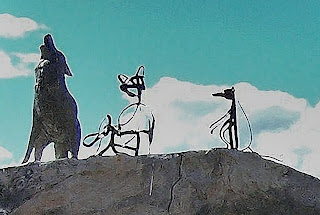"Even the most progressive western philosophers still generally believe that listening to the land is a metaphor. It's not a metaphor. It's how the world is." ~ Jeanette Armstrong (Syilx)
Art enriches our world in so many ways and can mean different things to different people. It can offer delight to our eyes, joy to our spirits, and serious contemplation to our minds. Sometimes it is deeply disturbing, causing us to face a truth (or fabrication...) that makes us uncomfortable. If we are open to the possibilities, it can offer us a different, perhaps new, way to view our world.
BAM! Face to face with the earth -
layer upon endless layer.
Where are we, here, today?
How many have come before?
...and before them?
In this vast land of space and sky,
mountains and grasslands,
The Chief offers peace to all who come,
to his creator above.
He is brother to coyote, eagle,
and one with the earth.
I am dwarfed and awed by his presence.
Scattered throughout the Okanagan Valley on cliffs and in caves are hundreds of drawings, evidence of a culture that has flourished in this area for thousands of years - long before the rest of us came.
Water runs into fish into bear
into rocks into mountains into sky,
through all living things.
It is precious beyond measure.
Different though we may be,
We are all formed from earth,
made up of the same materials.
Loaned to us for a brief instant,
it is only a matter of time
before we return to it.
The NK'MIP desert lands are one of Canada's three most endangered eco-systems and home to many endangered plant and animal species.
The energy and life of one
passes into another
as it has always been,
and so it goes
eon after eon.
Okanagan First Nations once traveled widely to fishing, gathering and hunting areas. Their dwellings were made of portable, reusable materials. In the summer, lodges covered with bark or mats of tule or grass were used.

Women gathered harvests of roots, tubers, and berries.
a place of security and warmth,
whether real or perceived.
whether real or perceived.
I could be at home here -
huddle 'round a fire with friends and family.
I would gather the tule,
if you'd show me how to weave it.
Major rivers supported annual runs of Pacific Salmon and other fish, which were a traditional mainstay of subsistence. Much meat was smoked or dried to carry them through the long, cold winters.
if you'd help me make the tool.

We would work together
on the vast plateau.

You are skilled at making clothing,
hats, and jewelry
from whatever is at hand.
I am eager to learn...
show me your ways.
Your life seems idyllic,
but it could not have been easy.
The game and fish were not always plentiful,
the streams did not always flow;
the roots were not always enough
for the long winter ahead.
Your stories flowed plentiful
through the tongues of your elders,
your ancestors,
into a future you could not even see.
Preserving ritual, religion, tradition
passed down to future generations
who need to remember
how it once was.
Similar to pit houses, sweat lodges were built for men and the ceremonial cleansing of body and spirit. All of these traditional-style dwellings were generally last used in the Canadian Plateau around the mid to late 1800s, although in some areas their use extended into the early 1900s. Today, they are no more.

that represent the nine known Indian bands
of the 1880's.
The Unity symbolism originated as part
of the modern North American
Aboriginal Unity Ride ceremony.
The names of many of the settlements in the Okanagan Valley–Osoyoos, Keremeos, Penticton and Kelowna–come from aboriginal words for these settled areas and attest to the long history of the Syilx people on this land. The Syilx of the Okanagan Nation live in eight communities in the interior of British Columbia and Washington. Over 400 band members live and work on the Osoyoos Indian Reserve which stretches from Oliver to Osoyoos.
The Osoyoos Indian Band acknowledges the ancestors and elders who have carried on their traditions and kept their language, history and culture alive so that it can shared with guests and visitors. The Band has a strong vision for its future and for the region.
I am eager to learn...
show me your ways.
Osoyoos, BC, Canada was originally called ‘Souyoos’ which translates as “the narrow waterway where the land almost meets” and is the southern most town of the Okanagan Valley, just 2 km (1.2 mi) north of the US border.
These sculptures are the work of
Virgil “Smoker” Marchand,
a member of the Colville Eastside Reservation
in Omak, Washington.












This was fascinating! And such beautiful artwork! Thanks for bringing us along. :)
ReplyDeleteA touching post - and so very interesting and informative. Thank you. When we visit eastern Washington again we hope to make a trip up to visit this area.
ReplyDeleteThanks, ladies, for stopping by. Osoyoos really is an interesting place to visit!
ReplyDeleteA wonderful journey for this morning. The photos are gorgeous both in color and in composition. The flow of the story with photos, poetry and narrative is fascinating with a flow and life of its own. Fantastic!
ReplyDelete...how did i miss this? i thought i was all caught up!
ReplyDeletethis is an amazing post! i LOVE it all! i would LOVE to go there and see all this beautiful art in person...but in the meantime...your pictures...and words...have taken me on an unforgettable journey! OH, i LOVE this...did i say that already???!!
thanks for taking us...